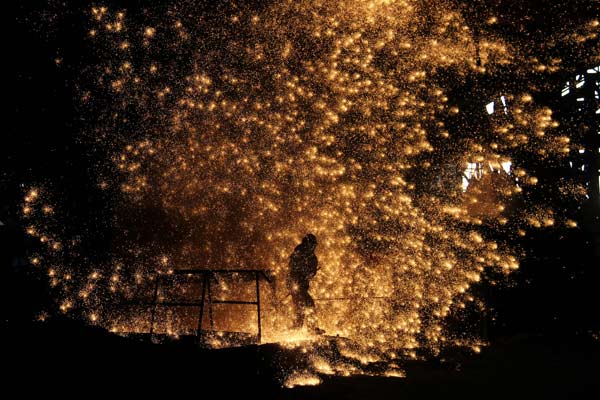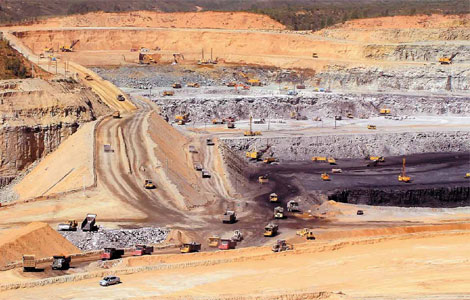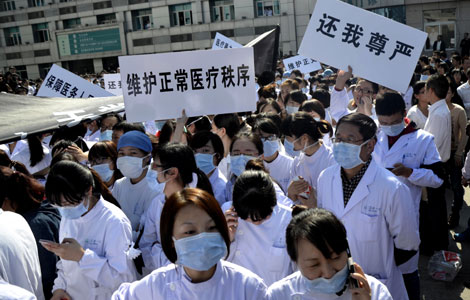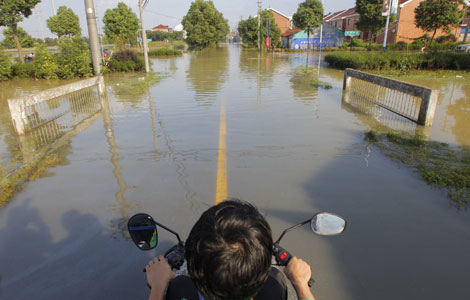New warning on overcapacity
Updated: 2013-11-05 00:17
By Zheng Yangpeng (China Daily)
|
|||||||||||
Banks told not to lend to projects in five sectors
 |
|
Workers labor at an iron and steel company in Laiwu, Shandong province. The industry is burdened with excess capacity, and it’s losing money. The central government has announced measures to cut the sector’s capacity and improve its efficiency. Xu Hongxing / For China Daily |
China's central ministries on Monday sent a stern message about the implementation of a key State Council document aimed at tackling excess industrial capacity.
The ministries underscored the increasing urgency of containing the risks of the longstanding issue.
In a video conference, officials from the National Development and Reform Commission and the Ministry of Industry and Information Technology, the two bodies with primary responsibility for the problem, urged local governments to implement a directive from the State Council, which is the country's cabinet.
"Local governments will be held accountable on this issue. Those who still violate discipline will be heavily punished. Officials should not bet on infringement without exposure," Hu Zucai, deputy director of the NDRC, said during the meeting.
On Oct 15, the State Council issued "guiding opinions" on solving the capacity issue. The document ordered a halt to the construction of new capacity in sectors burdened by excess production facilities.
The council also said that projects on which construction hadn't yet started should be canceled. Projects that were under construction at that point are to be halted unless they receive central government approval.
The document singled out five sectors — steel, flat glass, cement, electrolytic aluminum and shipbuilding — as having severe excess capacity, and it listed specific measures for each industry.
According to official data, the cement industry had the lowest capacity utilization rate, which was 71.9 percent at the end of 2012.
The rate for steel was 72 percent, while that for the glass industry was 73.1 percent.
A capacity utilization rate of 70 to 75 percent is regarded as a sign of "medium-level" excess capacity in manufacturing.
China's excess capacity issue has become so severe that President Xi Jinping has made special comments on the issue four times this year.
"Increasingly, excess capacity has become a salient problem in the economy and the root cause of many issues," Xi was quoted as saying at one point.
"If solved properly, China's economic structural upgrading will make big progress. If not, new problems could arise and even trigger an economic crisis."
"Excess capacity is not new to China. But the current level, given its scope, number and influence, is unprecedented," Zhu Hongren, chief engineer of the Ministry of Industry and Information Technology, said during the meeting.
"Some local governments favored fast growth too much and relied on investment too much.
"They have tried all means, including offering cheap land, electricity and tax breaks, to attract investment. That strategy has exacerbated continued construction and capacity expansion," said Zhu.
The NDRC said barriers to entry and environmental standards will be two key indicators for phasing out old capacity or adding new capacity.
On the same day, Shang Fulin, chairman of the China Banking Regulatory Commission, said during a meeting with bank executives in the eastern province of Fujian that banks should try to head off a rise in bad loans from industries with excess capacity.
He said banks should also step up efforts to write off some of the nonperforming loans on their books.
Shang said that any form of new credit is prohibited for new projects in industries with overcapacity, and banks shouldn't extend loans or provide funds by issuing wealth management products to back projects that don't have the relevant government approvals.
Related Stories
China to cut overcapacity 2013-10-16 13:54
China issues guideline to cut overcapacity 2013-10-15 16:54
China exploring ways to ease overcapacity 2013-09-18 21:30
Overcapacity obsession 2013-08-19 07:58
China accelerates overcapacity reduction 2013-08-17 15:16
Overcapacity sends China's steel sector into loss 2013-08-01 10:38
Today's Top News
Expats disobeying courts to be barred from leaving
Pollution 'to ease in five to 10 years'
Report highlights smog effects
Factories going green, efficient
Govt to focus on better service
Luxury shoppers get more sophisticated
Li urges farmers to plant more in 2014
Xi calls for targeted policies to fight poverty
Hot Topics
Lunar probe , China growth forecasts, Emission rules get tougher, China seen through 'colored lens', International board,
Editor's Picks

|

|

|

|

|

|





